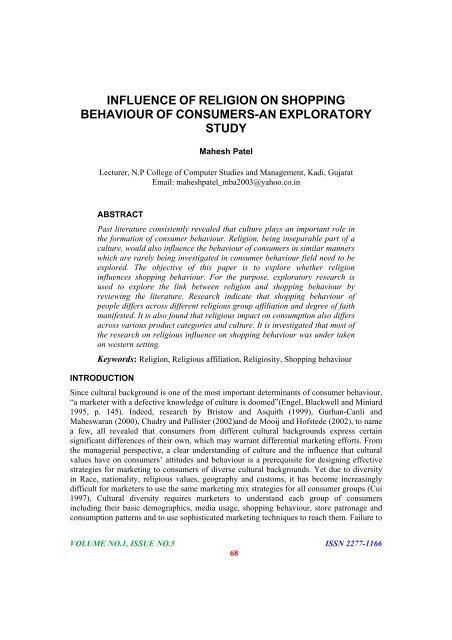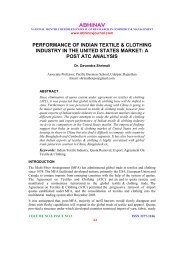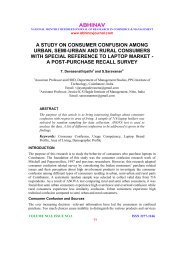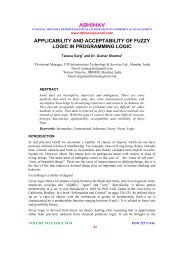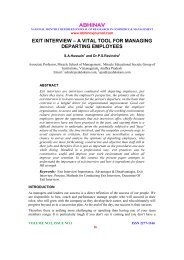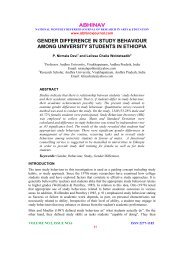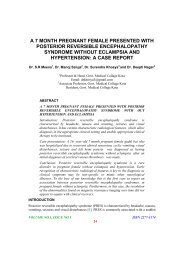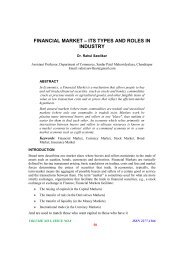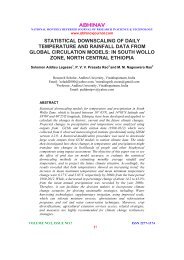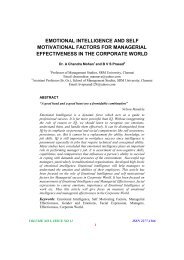Influence of religion on shopping behavior of consumers - Abhinav ...
Influence of religion on shopping behavior of consumers - Abhinav ...
Influence of religion on shopping behavior of consumers - Abhinav ...
You also want an ePaper? Increase the reach of your titles
YUMPU automatically turns print PDFs into web optimized ePapers that Google loves.
INFLUENCE OF RELIGION ON SHOPPING<br />
BEHAVIOUR OF CONSUMERS-AN EXPLORATORY<br />
STUDY<br />
Mahesh Patel<br />
Lecturer, N.P College <str<strong>on</strong>g>of</str<strong>on</strong>g> Computer Studies and Management, Kadi, Gujarat<br />
Email: maheshpatel_mba2003@yahoo.co.in<br />
ABSTRACT<br />
Past literature c<strong>on</strong>sistently revealed that culture plays an important role in<br />
the formati<strong>on</strong> <str<strong>on</strong>g>of</str<strong>on</strong>g> c<strong>on</strong>sumer behaviour. Religi<strong>on</strong>, being inseparable part <str<strong>on</strong>g>of</str<strong>on</strong>g> a<br />
culture, would also influence the behaviour <str<strong>on</strong>g>of</str<strong>on</strong>g> c<strong>on</strong>sumers in similar manners<br />
which are rarely being investigated in c<strong>on</strong>sumer behaviour field need to be<br />
explored. The objective <str<strong>on</strong>g>of</str<strong>on</strong>g> this paper is to explore whether <str<strong>on</strong>g>religi<strong>on</strong></str<strong>on</strong>g><br />
influences <strong>shopping</strong> behaviour. For the purpose, exploratory research is<br />
used to explore the link between <str<strong>on</strong>g>religi<strong>on</strong></str<strong>on</strong>g> and <strong>shopping</strong> behaviour by<br />
reviewing the literature. Research indicate that <strong>shopping</strong> behaviour <str<strong>on</strong>g>of</str<strong>on</strong>g><br />
people differs across different religious group affiliati<strong>on</strong> and degree <str<strong>on</strong>g>of</str<strong>on</strong>g> faith<br />
manifested. It is also found that religious impact <strong>on</strong> c<strong>on</strong>sumpti<strong>on</strong> also differs<br />
across various product categories and culture. It is investigated that most <str<strong>on</strong>g>of</str<strong>on</strong>g><br />
the research <strong>on</strong> religious influence <strong>on</strong> <strong>shopping</strong> behaviour was under taken<br />
<strong>on</strong> western setting.<br />
Keywords: Religi<strong>on</strong>, Religious affiliati<strong>on</strong>, Religiosity, Shopping behaviour<br />
INTRODUCTION<br />
Since cultural background is <strong>on</strong>e <str<strong>on</strong>g>of</str<strong>on</strong>g> the most important determinants <str<strong>on</strong>g>of</str<strong>on</strong>g> c<strong>on</strong>sumer behaviour,<br />
“a marketer with a defective knowledge <str<strong>on</strong>g>of</str<strong>on</strong>g> culture is doomed”(Engel, Blackwell and Miniard<br />
1995, p. 145). Indeed, research by Bristow and Asquith (1999), Gurhan-Canli and<br />
Maheswaran (2000), Chudry and Pallister (2002)and de Mooij and H<str<strong>on</strong>g>of</str<strong>on</strong>g>stede (2002), to name<br />
a few, all revealed that c<strong>on</strong>sumers from different cultural backgrounds express certain<br />
significant differences <str<strong>on</strong>g>of</str<strong>on</strong>g> their own, which may warrant differential marketing efforts. From<br />
the managerial perspective, a clear understanding <str<strong>on</strong>g>of</str<strong>on</strong>g> culture and the influence that cultural<br />
values have <strong>on</strong> c<strong>on</strong>sumers’ attitudes and behaviour is a prerequisite for designing effective<br />
strategies for marketing to c<strong>on</strong>sumers <str<strong>on</strong>g>of</str<strong>on</strong>g> diverse cultural backgrounds. Yet due to diversity<br />
in Race, nati<strong>on</strong>ality, religious values, geography and customs, it has become increasingly<br />
difficult for marketers to use the same marketing mix strategies for all c<strong>on</strong>sumer groups (Cui<br />
1997). Cultural diversity requires marketers to understand each group <str<strong>on</strong>g>of</str<strong>on</strong>g> c<strong>on</strong>sumers<br />
including their basic demographics, media usage, <strong>shopping</strong> behaviour, store patr<strong>on</strong>age and<br />
c<strong>on</strong>sumpti<strong>on</strong> patterns and to use sophisticated marketing techniques to reach them. Failure to<br />
VOLUME NO.1, ISSUE NO.5 ISSN 2277-1166<br />
68
ABHINAV<br />
NATIONAL MONTHLY REFEREED JOURNAL OF REASEARCH IN COMMERCE & MANAGEMENT<br />
www.abhinavjournal.com<br />
customise their <str<strong>on</strong>g>of</str<strong>on</strong>g>ferings to cultural variati<strong>on</strong>s would also result in the failure <str<strong>on</strong>g>of</str<strong>on</strong>g> marketing<br />
programmes directed to a specific market segment.<br />
From a marketing point <str<strong>on</strong>g>of</str<strong>on</strong>g> view, the stability <str<strong>on</strong>g>of</str<strong>on</strong>g> <str<strong>on</strong>g>religi<strong>on</strong></str<strong>on</strong>g> underlying c<strong>on</strong>sumer <strong>behavior</strong><br />
implies the potential <str<strong>on</strong>g>of</str<strong>on</strong>g> <str<strong>on</strong>g>religi<strong>on</strong></str<strong>on</strong>g> as the basis for market targeting and strategies (Delener,<br />
1990a). This is because much informati<strong>on</strong> about typical c<strong>on</strong>sumers is in a state <str<strong>on</strong>g>of</str<strong>on</strong>g> flux, that<br />
is, the relevancy <str<strong>on</strong>g>of</str<strong>on</strong>g> certain characteristics to an individual or a group might change<br />
depending up<strong>on</strong> time and situati<strong>on</strong>. Indeed, marketers cannot rely heavily <strong>on</strong> the implicati<strong>on</strong>s<br />
related to c<strong>on</strong>sumers’ basic demographics such as discreti<strong>on</strong>ary income, educati<strong>on</strong><br />
attainment, chr<strong>on</strong>ological age and employment status, as these characteristics change over<br />
time and from <strong>on</strong>e generati<strong>on</strong> to the next, thus hampering marketers in segmenting the<br />
market to its full potential (McDaniel and Burnett, 1990).<br />
Being able to identify how the <strong>behavior</strong> <str<strong>on</strong>g>of</str<strong>on</strong>g> c<strong>on</strong>sumers is affected by their religiosity factors<br />
is critical to the success <str<strong>on</strong>g>of</str<strong>on</strong>g> marketers, especially for those who operate in multi-religious<br />
countries like India. Perhaps the major challenge for them is to understand the differences<br />
and similarities that characterize c<strong>on</strong>sumers’ <strong>behavior</strong> across different religious. Though<br />
marketers can use a standardized approach by focusing <strong>on</strong> comm<strong>on</strong> basic needs for all<br />
c<strong>on</strong>sumers, they seem to underestimate the pr<str<strong>on</strong>g>of</str<strong>on</strong>g>ound influence <str<strong>on</strong>g>of</str<strong>on</strong>g> religious differences<br />
am<strong>on</strong>g c<strong>on</strong>sumers <strong>on</strong> their choice and <strong>shopping</strong> <strong>behavior</strong>s. As such, the advantages <str<strong>on</strong>g>of</str<strong>on</strong>g> this<br />
approach are difficult to gain if c<strong>on</strong>sumers with different cultural backgrounds are not<br />
largely compelled by standardized marketing efforts because <str<strong>on</strong>g>of</str<strong>on</strong>g> their religious. Therefore, in<br />
order for marketers to develop effective marketing strategies for a specific culture, an<br />
intimate understanding yet comprehensive knowledge <str<strong>on</strong>g>of</str<strong>on</strong>g> how <strong>shopping</strong> <strong>behavior</strong> <str<strong>on</strong>g>of</str<strong>on</strong>g><br />
c<strong>on</strong>sumers is c<strong>on</strong>stantly affected by their religious values is apparently warranted.<br />
This paper is <str<strong>on</strong>g>of</str<strong>on</strong>g> c<strong>on</strong>ceptual in nature which focuses <strong>on</strong> how <str<strong>on</strong>g>religi<strong>on</strong></str<strong>on</strong>g> influences the <strong>shopping</strong><br />
<strong>behavior</strong> <str<strong>on</strong>g>of</str<strong>on</strong>g> c<strong>on</strong>sumer. The prime objective <str<strong>on</strong>g>of</str<strong>on</strong>g> this research paper is to explore the<br />
relati<strong>on</strong>ship between <str<strong>on</strong>g>religi<strong>on</strong></str<strong>on</strong>g> and c<strong>on</strong>sumpti<strong>on</strong> <strong>behavior</strong>. Generally a base <str<strong>on</strong>g>of</str<strong>on</strong>g> past empirical<br />
research <strong>on</strong> religious influence <strong>on</strong> c<strong>on</strong>sumpti<strong>on</strong> <strong>behavior</strong> is taken to understand the<br />
c<strong>on</strong>ceptual ground <str<strong>on</strong>g>of</str<strong>on</strong>g> the research. Exploratory research design is used for the purpose <str<strong>on</strong>g>of</str<strong>on</strong>g><br />
study.<br />
The paper starts with abstract followed by introducti<strong>on</strong> which gives an idea about the<br />
relevance <str<strong>on</strong>g>of</str<strong>on</strong>g> the study. Next to it, a <str<strong>on</strong>g>religi<strong>on</strong></str<strong>on</strong>g> is defined from the c<strong>on</strong>text <str<strong>on</strong>g>of</str<strong>on</strong>g> religious<br />
affiliati<strong>on</strong> and religiosity which is followed by literature review. A research methodology is<br />
discussed after literature review which is followed by findings and c<strong>on</strong>clusi<strong>on</strong>.<br />
Religi<strong>on</strong> defined<br />
The search for a generally accepted theory or definiti<strong>on</strong> faces enormous difficulties in the<br />
case <str<strong>on</strong>g>of</str<strong>on</strong>g> <str<strong>on</strong>g>religi<strong>on</strong></str<strong>on</strong>g> (Clarke &Byrne, 1993). Scholars identify at least three historical<br />
designati<strong>on</strong>s <str<strong>on</strong>g>of</str<strong>on</strong>g> the term: (1) a supernatural power to which individuals must resp<strong>on</strong>d; (2) a<br />
feeling present in the individual who c<strong>on</strong>ceives such a power; and (3) the ritual acts carried<br />
out in respect <str<strong>on</strong>g>of</str<strong>on</strong>g> that power (Wulff, 1997). Such designati<strong>on</strong>s have defied social scientific<br />
c<strong>on</strong>sensus and thus “it is hard to make any generalizati<strong>on</strong> [c<strong>on</strong>cerning <str<strong>on</strong>g>religi<strong>on</strong></str<strong>on</strong>g>] that is<br />
universally valid” (Peters<strong>on</strong>, 2001, p. 6). As a result, different theories and definiti<strong>on</strong>s <str<strong>on</strong>g>of</str<strong>on</strong>g><br />
<str<strong>on</strong>g>religi<strong>on</strong></str<strong>on</strong>g> are <str<strong>on</strong>g>of</str<strong>on</strong>g>ten used in the literature. Am<strong>on</strong>g others, <str<strong>on</strong>g>religi<strong>on</strong></str<strong>on</strong>g> has been defined as:<br />
VOLUME NO.1, ISSUE NO.5 ISSN 2277-1166<br />
69
ABHINAV<br />
NATIONAL MONTHLY REFEREED JOURNAL OF REASEARCH IN COMMERCE & MANAGEMENT<br />
www.abhinavjournal.com<br />
“A belief in God accompanied by a commitment to follow principles believed to be set forth<br />
by God”. (McDaniel & Burnett, 1990, p. 110)<br />
“A socially shared set <str<strong>on</strong>g>of</str<strong>on</strong>g> beliefs, ideas and acti<strong>on</strong>s that relate to a reality that cannot be<br />
verified empirically yet is believed to affect the course <str<strong>on</strong>g>of</str<strong>on</strong>g> natural and human events”.<br />
(Terpstra & David, 1991, p. 73)<br />
“An organised system <str<strong>on</strong>g>of</str<strong>on</strong>g> beliefs, practices, rituals and symbols designed (a) to facilitate<br />
closeness to the sacred or transcendent (God, higher power or ultimate truth/reality), and (b)<br />
to foster an understanding <str<strong>on</strong>g>of</str<strong>on</strong>g> <strong>on</strong>e’s relati<strong>on</strong> and resp<strong>on</strong>sibility to others in living together in a<br />
community”. (Koenig, McCullough & Lars<strong>on</strong>, 2000, p. 18)<br />
“A social arrangement designed to provide a shared, collective way <str<strong>on</strong>g>of</str<strong>on</strong>g> dealing with the<br />
unknown and un-knowable aspects <str<strong>on</strong>g>of</str<strong>on</strong>g> human life, with the mysteries <str<strong>on</strong>g>of</str<strong>on</strong>g> life, death and the<br />
different dilemmas that arise in the process <str<strong>on</strong>g>of</str<strong>on</strong>g> making moral decisi<strong>on</strong>s”. (Johns<strong>on</strong>, 2000, p.<br />
259)<br />
“A cultural subsystem that refers to a unified system <str<strong>on</strong>g>of</str<strong>on</strong>g> beliefs and practices relative to a<br />
sacred ultimate reality or deity”. (Arnould, Price & Zikhan, 2004, p. 517-518)<br />
“A system <str<strong>on</strong>g>of</str<strong>on</strong>g> beliefs about the supernatural and spiritual world, about God, and about how<br />
humans, as God’s creatures, are supposed to behave <strong>on</strong> this earth”. (Sheth & Mittal, 2004, p.<br />
65)<br />
Religi<strong>on</strong> can be viewed in two broad perspectives. Individual associati<strong>on</strong> with a particular<br />
<str<strong>on</strong>g>religi<strong>on</strong></str<strong>on</strong>g> and commitment an individual is having for the <str<strong>on</strong>g>religi<strong>on</strong></str<strong>on</strong>g> <strong>on</strong>e is pr<str<strong>on</strong>g>of</str<strong>on</strong>g>essing.<br />
Religious Affiliati<strong>on</strong><br />
Religious affiliati<strong>on</strong> or adherence <str<strong>on</strong>g>of</str<strong>on</strong>g> individual to a particular religious group has been<br />
termed an ascribed status. This is because like race and nati<strong>on</strong>ality, its effect <strong>on</strong> individual<br />
life <str<strong>on</strong>g>of</str<strong>on</strong>g>ten predates birth, determines family size, level <str<strong>on</strong>g>of</str<strong>on</strong>g> educati<strong>on</strong> attained, the amount <str<strong>on</strong>g>of</str<strong>on</strong>g><br />
wealth accumulated and the type <str<strong>on</strong>g>of</str<strong>on</strong>g> life decisi<strong>on</strong> taken.( Hirschman 1983)<br />
It is suggested that <strong>on</strong>e is born into a religious traditi<strong>on</strong> and through the acti<strong>on</strong> <str<strong>on</strong>g>of</str<strong>on</strong>g> its<br />
instituti<strong>on</strong>al influences (i.e. Sunday school, church attendance) develops a religious identity<br />
or affiliati<strong>on</strong>. Religious affiliati<strong>on</strong>s therefore can be depicted as “cognitive systems” <str<strong>on</strong>g>of</str<strong>on</strong>g> the<br />
society. In fact, even within the same ethnic group, religious subculture stands as a sacred<br />
value that differentiates people’s attitude and behaviour. Irish ethnicity, for instance, may be<br />
exhibited quite differently, depending up<strong>on</strong> whether <strong>on</strong>e is Irish Catholic or Irish Protestant.<br />
Without religious differences, their ethnic differences almost certainly would be less distinct.<br />
It has been measured relative to denominati<strong>on</strong>al membership or faith identificati<strong>on</strong> <str<strong>on</strong>g>of</str<strong>on</strong>g> the<br />
individual (e.g. Catholic, Protestant, Jews).<br />
Religious affiliati<strong>on</strong> is viewed as sharing a comm<strong>on</strong> cognitive system <str<strong>on</strong>g>of</str<strong>on</strong>g> beliefs, values,<br />
expectati<strong>on</strong>s and behaviour (Hirschman 1983).<br />
Religious affiliati<strong>on</strong> has typically been measured relative to religious denominati<strong>on</strong>al<br />
membership or religious identificati<strong>on</strong> <str<strong>on</strong>g>of</str<strong>on</strong>g> the individual.<br />
VOLUME NO.1, ISSUE NO.5 ISSN 2277-1166<br />
70
ABHINAV<br />
NATIONAL MONTHLY REFEREED JOURNAL OF REASEARCH IN COMMERCE & MANAGEMENT<br />
www.abhinavjournal.com<br />
Religiosity<br />
According to Delener (1990b), religiosity (degree to which individuals are committed to a<br />
specific religious group) is <strong>on</strong>e <str<strong>on</strong>g>of</str<strong>on</strong>g> the most cultural force and key influence in. buying<br />
behaviour. This is because purchase decisi<strong>on</strong> is categorised according how much c<strong>on</strong>sumers<br />
adhere to a particular faith.The extent to which <str<strong>on</strong>g>religi<strong>on</strong></str<strong>on</strong>g> affects <strong>on</strong>e’s beliefs and behaviour<br />
depends <strong>on</strong> the individual’s level <str<strong>on</strong>g>of</str<strong>on</strong>g> religiosity and the importance <strong>on</strong>e places <strong>on</strong> the <str<strong>on</strong>g>religi<strong>on</strong></str<strong>on</strong>g><br />
itself (Sood and Nasu, 1995).<br />
It has been argued that <str<strong>on</strong>g>religi<strong>on</strong></str<strong>on</strong>g> is highly pers<strong>on</strong>al in nature and therefore its effects <strong>on</strong><br />
c<strong>on</strong>sumer behaviour depend <strong>on</strong> individuals’ level <str<strong>on</strong>g>of</str<strong>on</strong>g> religious commitment or the importance<br />
placed <strong>on</strong> <str<strong>on</strong>g>religi<strong>on</strong></str<strong>on</strong>g> in their life.<br />
The degree to which a pers<strong>on</strong> uses adheres to his or her religious values, beliefs and practices<br />
and uses them in daily living. The suppositi<strong>on</strong> is that a highly religious pers<strong>on</strong> will evaluate<br />
the world through religious schemas and thus will integrate his or her <str<strong>on</strong>g>religi<strong>on</strong></str<strong>on</strong>g> into much <str<strong>on</strong>g>of</str<strong>on</strong>g><br />
his or her life. Worthingt<strong>on</strong> et al. (2003, p. 85)<br />
Religiosity or religious commitment is “the extent to which an individual’s committed to the<br />
<str<strong>on</strong>g>religi<strong>on</strong></str<strong>on</strong>g> he or she pr<str<strong>on</strong>g>of</str<strong>on</strong>g>esses and its teachings, such as the individual attitudes and behaviours<br />
reflect this commitment” (Johns<strong>on</strong>, Jang, Lars<strong>on</strong> and Li, 2001: p. 25).<br />
LITERATURE REVIEW<br />
Religious affiliati<strong>on</strong> and <strong>shopping</strong> behaviour<br />
Within the c<strong>on</strong>sumer behaviour paradigm, religious affiliati<strong>on</strong> or the adherence <str<strong>on</strong>g>of</str<strong>on</strong>g><br />
individuals to religious groups has been termed an ascribed status. This is because, like race<br />
and nati<strong>on</strong>ality, its effect <strong>on</strong> the individual’s life <str<strong>on</strong>g>of</str<strong>on</strong>g>ten predates life, determines family size,<br />
the level <str<strong>on</strong>g>of</str<strong>on</strong>g> educati<strong>on</strong> attained, the amount <str<strong>on</strong>g>of</str<strong>on</strong>g> wealth accumulated and the type <str<strong>on</strong>g>of</str<strong>on</strong>g> life<br />
decisi<strong>on</strong> taken (Hirschman, 1983). It is suggested that <strong>on</strong>e is born into a religious traditi<strong>on</strong><br />
and through the acti<strong>on</strong> <str<strong>on</strong>g>of</str<strong>on</strong>g> its instituti<strong>on</strong>al influences (i.e. Sunday school, church attendance)<br />
develops a religious identity or affiliati<strong>on</strong>. Religious affiliati<strong>on</strong>s therefore can be depicted as<br />
“cognitive systems” <str<strong>on</strong>g>of</str<strong>on</strong>g> the society. That is, believers <str<strong>on</strong>g>of</str<strong>on</strong>g> the same religious affiliati<strong>on</strong> are<br />
viewed as sharing a comm<strong>on</strong> cognitive system <str<strong>on</strong>g>of</str<strong>on</strong>g> beliefs, values, expectati<strong>on</strong>s and<br />
behaviours (Hirschman, 1983).<br />
The little empirical evidence that has been accumulated indicates that religious affiliati<strong>on</strong> has<br />
the potential to be valuable predictor <str<strong>on</strong>g>of</str<strong>on</strong>g> c<strong>on</strong>sumer behaviour. One <str<strong>on</strong>g>of</str<strong>on</strong>g> the earliest marketing<br />
studies that investigated the influence <str<strong>on</strong>g>of</str<strong>on</strong>g> religious affiliati<strong>on</strong> <strong>on</strong> c<strong>on</strong>sumer behaviour was by<br />
Engel (1976) who noted sharp differences in the psychographic pr<str<strong>on</strong>g>of</str<strong>on</strong>g>iles between Lutheran<br />
Church and Assembly <str<strong>on</strong>g>of</str<strong>on</strong>g> God denominati<strong>on</strong>s in Brazil. He found that the Lutheran Church<br />
members are more secular and show relatively minimal interest in spiritual growth while<br />
Christianity has a c<strong>on</strong>siderable influence <strong>on</strong> the lifestyle <str<strong>on</strong>g>of</str<strong>on</strong>g> the Assembly <str<strong>on</strong>g>of</str<strong>on</strong>g> God members.<br />
Though the implicati<strong>on</strong>s <str<strong>on</strong>g>of</str<strong>on</strong>g> Engel’s findings are specific to the Brazilian c<strong>on</strong>sumer market,<br />
the study has empirically dem<strong>on</strong>strated that religious affiliati<strong>on</strong> and denominati<strong>on</strong> can serve<br />
as important variables for c<strong>on</strong>sumer segmentati<strong>on</strong>.<br />
In a study <strong>on</strong> religious affiliati<strong>on</strong> and store locati<strong>on</strong>, Thomps<strong>on</strong> and Raine (1976)<br />
investigated whether or not customers who shopped at <strong>on</strong>e furniture store differed from the<br />
general populati<strong>on</strong> <str<strong>on</strong>g>of</str<strong>on</strong>g> the city with regard to religious affiliati<strong>on</strong>, as well as whether religious<br />
VOLUME NO.1, ISSUE NO.5 ISSN 2277-1166<br />
71
ABHINAV<br />
NATIONAL MONTHLY REFEREED JOURNAL OF REASEARCH IN COMMERCE & MANAGEMENT<br />
www.abhinavjournal.com<br />
affiliati<strong>on</strong> was a significant determinant <str<strong>on</strong>g>of</str<strong>on</strong>g> furniture purchases at the store. They found that<br />
their results were not impressive and “generally disappointing” (p. 76), as religious<br />
affiliati<strong>on</strong> showed no significant relati<strong>on</strong>ship to furniture sales. Nevertheless, their findings<br />
provided some support (p = 0.10) for their hypothesis that the store had a greater amount <str<strong>on</strong>g>of</str<strong>on</strong>g><br />
sales coming from “a middle range <str<strong>on</strong>g>of</str<strong>on</strong>g> fundamentalist Protestant religious denominati<strong>on</strong>s” (p.<br />
72).<br />
A series <str<strong>on</strong>g>of</str<strong>on</strong>g> studies <strong>on</strong> religious affiliati<strong>on</strong> and its effects <strong>on</strong> c<strong>on</strong>sumer behaviour was d<strong>on</strong>e by<br />
Hirschman in the early 1980’s. Her studies mainly focused <strong>on</strong> the similarities and differences<br />
in c<strong>on</strong>sumpti<strong>on</strong>-related activities am<strong>on</strong>g c<strong>on</strong>sumers affiliated with Catholicism,<br />
Protestantism and Judaism <str<strong>on</strong>g>religi<strong>on</strong></str<strong>on</strong>g>s. Her studies showed that: 1) Jewish c<strong>on</strong>sumers tend to<br />
be more innovative and less brand and store loyal than n<strong>on</strong>-Jewish c<strong>on</strong>sumers (Hirschman,<br />
1981), 2) Catholic c<strong>on</strong>sumers are more influenced by price, locati<strong>on</strong>, transportati<strong>on</strong>, and<br />
mood in making entertainment related choices than are Protestant c<strong>on</strong>sumers (Hirschman,<br />
1982), and 3) Jewish, Catholic, and Protestant c<strong>on</strong>sumers use different evaluati<strong>on</strong> criteria in<br />
making entertainment, residential, transportati<strong>on</strong>, and pet choices (Hirschman, 1983).<br />
Religious affiliati<strong>on</strong> also appears to affect people’s media usage and preferences.<br />
Hirschman’s (1985) analysis <str<strong>on</strong>g>of</str<strong>on</strong>g> the linkage between religious subcultures and media c<strong>on</strong>tent<br />
preferences am<strong>on</strong>g college students found distinct differences between Protestants, Jewish<br />
and Catholics in several types <str<strong>on</strong>g>of</str<strong>on</strong>g> c<strong>on</strong>tent preferences including televisi<strong>on</strong> programmes,<br />
books and moti<strong>on</strong> picture. Although the sample characteristics do not allow for drawing<br />
generalisati<strong>on</strong>s <strong>on</strong> the basis <str<strong>on</strong>g>of</str<strong>on</strong>g> the findings, the study did support the general hypothesis that<br />
religious ethnicity are related to media c<strong>on</strong>tent preference. In this study, religious differences<br />
emerged in a majority <str<strong>on</strong>g>of</str<strong>on</strong>g> c<strong>on</strong>tent categories even when the major demographic factors <str<strong>on</strong>g>of</str<strong>on</strong>g><br />
age, educati<strong>on</strong> and occupati<strong>on</strong>al status were explicitly c<strong>on</strong>trolled.<br />
Evidence suggests that the influence <str<strong>on</strong>g>of</str<strong>on</strong>g> religious affiliati<strong>on</strong> <strong>on</strong> c<strong>on</strong>sumer behaviour is not<br />
restricted to c<strong>on</strong>sumer decisi<strong>on</strong>-making <str<strong>on</strong>g>of</str<strong>on</strong>g> purchasing durable goods but also <strong>on</strong> their choice<br />
and evaluati<strong>on</strong> <str<strong>on</strong>g>of</str<strong>on</strong>g> service providers. In an examinati<strong>on</strong> <str<strong>on</strong>g>of</str<strong>on</strong>g> hospitals, it was found that<br />
religious affiliati<strong>on</strong> <str<strong>on</strong>g>of</str<strong>on</strong>g> a hospital is important in influencing hospital selecti<strong>on</strong> and<br />
c<strong>on</strong>tributes to overall patient satisfacti<strong>on</strong> (Nix & Gibs<strong>on</strong>, 1989). This finding is later<br />
supported by Andaleeb (1993) who found that hospitals <str<strong>on</strong>g>of</str<strong>on</strong>g> a particular religious affiliati<strong>on</strong><br />
were more likely to be recalled, preferred and selected by people <str<strong>on</strong>g>of</str<strong>on</strong>g> the same religious<br />
affiliati<strong>on</strong>.<br />
McDaniel and Burnett’s (1991) study <str<strong>on</strong>g>of</str<strong>on</strong>g> the major media habits <str<strong>on</strong>g>of</str<strong>on</strong>g> evangelical (born-again)<br />
and n<strong>on</strong>-evangelical c<strong>on</strong>sumers dem<strong>on</strong>strated some differences between these two market<br />
segments. They found that, as compared to their n<strong>on</strong>-evangelical counterparts, evangelical<br />
c<strong>on</strong>sumers were generally lower in their newspaper readership, less likely to read business<br />
and skin magazines, less likely to listen to heavy rock or popular music and less likely to<br />
watch adult comedies or adventure dramas. However, they tend to read religious magazines<br />
and use religious broadcast media more <str<strong>on</strong>g>of</str<strong>on</strong>g>ten than did n<strong>on</strong>-evangelicals.<br />
Bailey and Sood (1993) examined the effects <str<strong>on</strong>g>of</str<strong>on</strong>g> religious affiliati<strong>on</strong> <strong>on</strong> c<strong>on</strong>sumer behaviour<br />
<str<strong>on</strong>g>of</str<strong>on</strong>g> six religious groups in Washingt<strong>on</strong> DC: Buddhism, Hinduism, Islam, Judaism, Catholic<br />
and Protestant. The underlying aim was to study how the minority religious groups’<br />
behaviour (i.e. Buddhism, Hinduism and Islam) differed from those in the majority (i.e.<br />
VOLUME NO.1, ISSUE NO.5 ISSN 2277-1166<br />
72
ABHINAV<br />
NATIONAL MONTHLY REFEREED JOURNAL OF REASEARCH IN COMMERCE & MANAGEMENT<br />
www.abhinavjournal.com<br />
Judaism, Catholic and Protestant). The research examined <strong>shopping</strong> behaviour for a<br />
relatively expensive stereo sound system. The results identified statistically significant<br />
differences in the c<strong>on</strong>sumer behaviour <str<strong>on</strong>g>of</str<strong>on</strong>g> different religious groups. They found that Muslim<br />
c<strong>on</strong>sumers were relatively more impetuous shoppers but less likely to be informed or risky<br />
shoppers. Hindus were found to be in rati<strong>on</strong>al shopper group while Catholics were less likely<br />
to be informed shoppers. Buddhists are the <strong>on</strong>ly minority religious members in the sample to<br />
report c<strong>on</strong>sumer behaviour similar to the societal norms.<br />
Essoo and Dibb (2004) c<strong>on</strong>ducted a similar study in Mauritius with a nati<strong>on</strong>al sample <str<strong>on</strong>g>of</str<strong>on</strong>g> 600<br />
resp<strong>on</strong>dents from three different <str<strong>on</strong>g>religi<strong>on</strong></str<strong>on</strong>g>s: Hinduism, Islam and Catholicism. The results<br />
c<strong>on</strong>firmed that there were still marked differences between Hindus and Muslims for all seven<br />
types <str<strong>on</strong>g>of</str<strong>on</strong>g> shopper: the demanding, practical, trendy, traditi<strong>on</strong>al, ec<strong>on</strong>omic, thoughtful and<br />
innovative shopper.<br />
More recently, Fam, Waller and Erdogan (2004) c<strong>on</strong>ducted a large-scale study that analyse<br />
the influence <str<strong>on</strong>g>of</str<strong>on</strong>g> <str<strong>on</strong>g>religi<strong>on</strong></str<strong>on</strong>g> and intensity <str<strong>on</strong>g>of</str<strong>on</strong>g> religious belief <strong>on</strong> attitudes towards the advertising<br />
<str<strong>on</strong>g>of</str<strong>on</strong>g> four c<strong>on</strong>troversial product groups namely gender/sex related, social/political, healthcare<br />
and addictive products. Student samples from four main religious groups -- Buddhism,<br />
Islam, Christianity and n<strong>on</strong>-religious believers (mainly Taoism and C<strong>on</strong>fucianism) across six<br />
different countries were included in their study. They found that the followers <str<strong>on</strong>g>of</str<strong>on</strong>g> these four<br />
religious denominati<strong>on</strong>s have different attitudes towards the four c<strong>on</strong>troversial product<br />
groups. The followers <str<strong>on</strong>g>of</str<strong>on</strong>g> Islamic faith were more likely to find advertising <str<strong>on</strong>g>of</str<strong>on</strong>g> all four product<br />
groups most <str<strong>on</strong>g>of</str<strong>on</strong>g>fensive relative to the other three groups.<br />
Religiosity and <strong>shopping</strong> behaviour<br />
Individuals’ level <str<strong>on</strong>g>of</str<strong>on</strong>g> religious commitment or the importance placed <strong>on</strong> <str<strong>on</strong>g>religi<strong>on</strong></str<strong>on</strong>g> in their life.<br />
In an empirical study <str<strong>on</strong>g>of</str<strong>on</strong>g> religiosity and c<strong>on</strong>sumer <strong>behavior</strong> am<strong>on</strong>g 602 mostly Protestant<br />
c<strong>on</strong>sumers, Wilkes et al. (1986) reached a significant c<strong>on</strong>clusi<strong>on</strong> that religiosity influences<br />
several aspects <str<strong>on</strong>g>of</str<strong>on</strong>g> c<strong>on</strong>sumer’s lifestyle, which eventually may affect choices and/or choice<br />
behaviour. When age, income and sex were c<strong>on</strong>trolled, the researchers found that people<br />
with a higher degree <str<strong>on</strong>g>of</str<strong>on</strong>g> religious commitment tend to be satisfied with their lives, have a<br />
more traditi<strong>on</strong>al sex-role orientati<strong>on</strong> and are more likely to be opini<strong>on</strong> leaders.<br />
McDaniel and Burnett (1990) investigated the influence <str<strong>on</strong>g>of</str<strong>on</strong>g> religiosity <strong>on</strong> the importance <str<strong>on</strong>g>of</str<strong>on</strong>g><br />
various retail department store attributes held by c<strong>on</strong>sumers. The results show that <strong>on</strong>e<br />
aspect <str<strong>on</strong>g>of</str<strong>on</strong>g> religiosity, religious commitment, particularly measured by cognitive religiosity<br />
and <strong>on</strong>e aspect <str<strong>on</strong>g>of</str<strong>on</strong>g> <strong>behavior</strong>al religiosity are significant in predicting the importance<br />
individuals place <strong>on</strong> certain retail evaluative criteria. C<strong>on</strong>sumers with a high degree <str<strong>on</strong>g>of</str<strong>on</strong>g><br />
cognitive religious commitment viewed sales pers<strong>on</strong>nel friendliness, <strong>shopping</strong> efficiency,<br />
and product quality as being <str<strong>on</strong>g>of</str<strong>on</strong>g> greater importance in selecting a retail store than did those<br />
low in cognitive religious commitment. Religious c<strong>on</strong>tributi<strong>on</strong>, a <strong>behavior</strong>al comp<strong>on</strong>ent <str<strong>on</strong>g>of</str<strong>on</strong>g><br />
religious commitment, was positively and significantly associated with sales pers<strong>on</strong>nel<br />
friendliness/assistance and credit availability.<br />
Sood and Nasu (1995) c<strong>on</strong>ducted a cross-cultural comparis<strong>on</strong> <str<strong>on</strong>g>of</str<strong>on</strong>g> the effects <str<strong>on</strong>g>of</str<strong>on</strong>g> religiosity <strong>on</strong><br />
general purchasing <strong>behavior</strong> for a sample <str<strong>on</strong>g>of</str<strong>on</strong>g> Japanese and American c<strong>on</strong>sumers. They<br />
suggested that there is no difference in c<strong>on</strong>sumer <strong>shopping</strong> <strong>behavior</strong> between devout and<br />
casually religious Japanese individuals and this could be attributed this to the fact that<br />
VOLUME NO.1, ISSUE NO.5 ISSN 2277-1166<br />
73
ABHINAV<br />
NATIONAL MONTHLY REFEREED JOURNAL OF REASEARCH IN COMMERCE & MANAGEMENT<br />
www.abhinavjournal.com<br />
<str<strong>on</strong>g>religi<strong>on</strong></str<strong>on</strong>g> is not an important element in overall Japanese culture. On the other hand, devout<br />
Protestants in the U.S.A. were found to be more ec<strong>on</strong>omic, buying product <strong>on</strong> sale, <strong>shopping</strong><br />
in stores with lower prices, being open to buying foreign-made goods, believing that there<br />
was little relati<strong>on</strong> between price and quality, tending to not believe advertising claims while<br />
preferring subtle and informative advertisements.<br />
Delener (1989) investigated differences in external search informati<strong>on</strong> and media usage<br />
patterns <str<strong>on</strong>g>of</str<strong>on</strong>g> Catholics and Jews, and the associated influence <str<strong>on</strong>g>of</str<strong>on</strong>g> religiosity. The findings<br />
indicated that Jews searched for informati<strong>on</strong> more than Catholics and that the difference was<br />
greater for n<strong>on</strong>-religious c<strong>on</strong>sumers. He also found differences in media usage between the<br />
two groups attributed to the religiosity <str<strong>on</strong>g>of</str<strong>on</strong>g> c<strong>on</strong>sumers in each religious group.<br />
In a study <str<strong>on</strong>g>of</str<strong>on</strong>g> religious influences <strong>on</strong> c<strong>on</strong>sumer innovativeness, Delener (1990a) used two<br />
types <str<strong>on</strong>g>of</str<strong>on</strong>g> measures <str<strong>on</strong>g>of</str<strong>on</strong>g> innovativeness: willingness to try new brands and a direct measure <str<strong>on</strong>g>of</str<strong>on</strong>g><br />
innovativeness. The study showed that Jews were more willing than Catholics to try new<br />
movies, new books and new magazine. He also found that religious Catholics were more<br />
brand innovative than n<strong>on</strong>-religious Catholics. In c<strong>on</strong>trast, n<strong>on</strong>-religious Jews were found to<br />
be more brand innovative than religious Jews. His findings are fairly c<strong>on</strong>sistent with those<br />
described by Hirschman (1981) who found that Jews to be more innovative than n<strong>on</strong>-Jews<br />
and to be potentially less store and brand loyal.<br />
A study by Delener (1990b) explored the effects <str<strong>on</strong>g>of</str<strong>on</strong>g> religiosity <strong>on</strong> perceived risks and<br />
uncertainty in durable good purchase decisi<strong>on</strong>. His study was <strong>on</strong> affluent Catholics and<br />
Jewish households in the Northeast <str<strong>on</strong>g>of</str<strong>on</strong>g> United States for the purchase <str<strong>on</strong>g>of</str<strong>on</strong>g> new cars and<br />
microwave ovens. The findings <str<strong>on</strong>g>of</str<strong>on</strong>g> the study suggested that Catholics were more likely to be<br />
sensitive to any potentially negative c<strong>on</strong>sequences <str<strong>on</strong>g>of</str<strong>on</strong>g> their purchase decisi<strong>on</strong>s. This<br />
sensitivity was more apparent am<strong>on</strong>g c<strong>on</strong>sumers with a high degree <str<strong>on</strong>g>of</str<strong>on</strong>g> religiosity. This<br />
attitude relates to the tendency <str<strong>on</strong>g>of</str<strong>on</strong>g> highly religious individuals to be less secure and low in<br />
self-c<strong>on</strong>fident as compared to less religious individuals.<br />
PROBLEM STATEMENT<br />
There is a c<strong>on</strong>siderable body <str<strong>on</strong>g>of</str<strong>on</strong>g> extant literature focused <strong>on</strong> culture and its influence <strong>on</strong><br />
various aspects <str<strong>on</strong>g>of</str<strong>on</strong>g> c<strong>on</strong>sumer <strong>behavior</strong>. However, am<strong>on</strong>g this body <str<strong>on</strong>g>of</str<strong>on</strong>g> work, there are limited<br />
examples <str<strong>on</strong>g>of</str<strong>on</strong>g> research that incorporate the role <str<strong>on</strong>g>of</str<strong>on</strong>g> <str<strong>on</strong>g>religi<strong>on</strong></str<strong>on</strong>g> as an element <str<strong>on</strong>g>of</str<strong>on</strong>g> culture with<br />
c<strong>on</strong>sumer <strong>behavior</strong>. Instead, researchers have mainly focused <strong>on</strong> other subcultural factors<br />
such as ethnicity, nati<strong>on</strong>ality and values as important predictors <str<strong>on</strong>g>of</str<strong>on</strong>g> c<strong>on</strong>sumer <strong>behavior</strong>.<br />
Being a part <str<strong>on</strong>g>of</str<strong>on</strong>g> the culture, <str<strong>on</strong>g>religi<strong>on</strong></str<strong>on</strong>g> would influence people values, belief and attitude which<br />
in turn would influence behavious as c<strong>on</strong>sumer. So it is imperative to examine and explore<br />
the relati<strong>on</strong>ship between <str<strong>on</strong>g>religi<strong>on</strong></str<strong>on</strong>g> and <strong>shopping</strong> behaviour.<br />
OBJECTIVES OF THE STUDY<br />
1. To assess the past empirical research <strong>on</strong> role <str<strong>on</strong>g>of</str<strong>on</strong>g> <str<strong>on</strong>g>religi<strong>on</strong></str<strong>on</strong>g> in <strong>shopping</strong> behaviour<br />
2. To examine whether <strong>shopping</strong> behaviour differs am<strong>on</strong>g different religious groups<br />
VOLUME NO.1, ISSUE NO.5 ISSN 2277-1166<br />
74
ABHINAV<br />
NATIONAL MONTHLY REFEREED JOURNAL OF REASEARCH IN COMMERCE & MANAGEMENT<br />
www.abhinavjournal.com<br />
RESEARCH METHODOLOGY<br />
This research is purely c<strong>on</strong>ceptual base in which exploratory research design is used to study<br />
the research problem. Generally past empirical research would have been taken to explore<br />
the relati<strong>on</strong>ship between individual religious background and <strong>shopping</strong> behaviour.<br />
FINDINGS<br />
Past research <strong>on</strong> c<strong>on</strong>sumer behaviour were mainly c<strong>on</strong>centrated <strong>on</strong> influence <str<strong>on</strong>g>of</str<strong>on</strong>g> culture <strong>on</strong><br />
various aspects <str<strong>on</strong>g>of</str<strong>on</strong>g> c<strong>on</strong>sumer buying behaviour. But the role <str<strong>on</strong>g>of</str<strong>on</strong>g> <str<strong>on</strong>g>religi<strong>on</strong></str<strong>on</strong>g> in shaping c<strong>on</strong>sumer<br />
behaviour was always been ignored though it immensely affects <strong>on</strong>es behaviour by<br />
influencing their culture, thinking and lifestyle.<br />
From this exploratory research, it is found that there are two broad aspects <str<strong>on</strong>g>of</str<strong>on</strong>g> <str<strong>on</strong>g>religi<strong>on</strong></str<strong>on</strong>g>;<br />
religious affiliati<strong>on</strong> and religiosity which influence <strong>shopping</strong> behaviour differently. It is<br />
c<strong>on</strong>cluded that c<strong>on</strong>sumer affiliati<strong>on</strong> to different <str<strong>on</strong>g>religi<strong>on</strong></str<strong>on</strong>g> results in <strong>shopping</strong> behaviour. It is<br />
also found that degree <str<strong>on</strong>g>of</str<strong>on</strong>g> faith and belief in a particular <str<strong>on</strong>g>religi<strong>on</strong></str<strong>on</strong>g> would also affects <strong>shopping</strong><br />
behaviour <str<strong>on</strong>g>of</str<strong>on</strong>g> c<strong>on</strong>sumer. It means that religious and n<strong>on</strong>-religious c<strong>on</strong>sumers are different in<br />
their choices and expectati<strong>on</strong>s which results into various <strong>shopping</strong> behaviour.<br />
Religi<strong>on</strong> influences c<strong>on</strong>sumer <strong>shopping</strong> behaviour by influencing their pers<strong>on</strong>ality by way <str<strong>on</strong>g>of</str<strong>on</strong>g><br />
their beliefs, values and attitudes and influencing their lifestyle, informati<strong>on</strong> sources and<br />
<strong>shopping</strong> orientati<strong>on</strong>.<br />
It is found that influence <str<strong>on</strong>g>religi<strong>on</strong></str<strong>on</strong>g> <strong>on</strong> <strong>shopping</strong> behaviour is widely different for different<br />
product categories and most <str<strong>on</strong>g>of</str<strong>on</strong>g> the research <strong>on</strong> <str<strong>on</strong>g>religi<strong>on</strong></str<strong>on</strong>g> and c<strong>on</strong>sumer behaviour were<br />
c<strong>on</strong>ducted in United States where Judeo-Christian culture is predominant.<br />
SCOPE FOR FUTURE RESEARCH<br />
Most <str<strong>on</strong>g>of</str<strong>on</strong>g> the researches which were c<strong>on</strong>ducted in the past were in the western setting which<br />
impels that future research can be c<strong>on</strong>ducted in n<strong>on</strong>-western setting as the degree <str<strong>on</strong>g>of</str<strong>on</strong>g><br />
influence <str<strong>on</strong>g>of</str<strong>on</strong>g> <str<strong>on</strong>g>religi<strong>on</strong></str<strong>on</strong>g> and religiosity differs from <strong>on</strong>e culture to another. Another implicati<strong>on</strong><br />
for the future research is that most <str<strong>on</strong>g>of</str<strong>on</strong>g> the researches c<strong>on</strong>ducted were for the high<br />
involvement which indicates that it is required to study whether buying behaviour or<br />
<strong>shopping</strong> behaviour for low involvement product would be influenced by religious<br />
background and degree <str<strong>on</strong>g>of</str<strong>on</strong>g> commitment <strong>on</strong>e hold for the <str<strong>on</strong>g>religi<strong>on</strong></str<strong>on</strong>g> he or she pr<str<strong>on</strong>g>of</str<strong>on</strong>g>esses.<br />
Even this is a kind <str<strong>on</strong>g>of</str<strong>on</strong>g> exploratory research which could more authentically be carried out by<br />
using scale measurement for measuring religiosity and <strong>shopping</strong> behaviour.<br />
CONCLUSION<br />
The above review makes it clear that different <str<strong>on</strong>g>religi<strong>on</strong></str<strong>on</strong>g>s have different impacts <strong>on</strong> some<br />
aspects <str<strong>on</strong>g>of</str<strong>on</strong>g> c<strong>on</strong>sumer behaviour. These differences are thought to result from divergent values<br />
and beliefs c<strong>on</strong>cerning c<strong>on</strong>sumpti<strong>on</strong> held by different religious ideologies. This effect may<br />
be either direct, as when c<strong>on</strong>sumpti<strong>on</strong> <str<strong>on</strong>g>of</str<strong>on</strong>g> specific products varies as a functi<strong>on</strong> <str<strong>on</strong>g>of</str<strong>on</strong>g> the tenets<br />
held by the religious traditi<strong>on</strong>s, or indirectly, as a functi<strong>on</strong> <str<strong>on</strong>g>of</str<strong>on</strong>g> differences in psychological<br />
C<strong>on</strong>structs such as pers<strong>on</strong>ality and values.<br />
VOLUME NO.1, ISSUE NO.5 ISSN 2277-1166<br />
75
ABHINAV<br />
NATIONAL MONTHLY REFEREED JOURNAL OF REASEARCH IN COMMERCE & MANAGEMENT<br />
www.abhinavjournal.com<br />
The findings give c<strong>on</strong>siderable support for viewing <str<strong>on</strong>g>religi<strong>on</strong></str<strong>on</strong>g> as an important c<strong>on</strong>struct in the<br />
study <str<strong>on</strong>g>of</str<strong>on</strong>g> c<strong>on</strong>sumer <strong>behavior</strong>. Firstly, <str<strong>on</strong>g>religi<strong>on</strong></str<strong>on</strong>g> was found to influence the way in which people<br />
make decisi<strong>on</strong>s <strong>on</strong> <strong>shopping</strong>. In the c<strong>on</strong>sumer <strong>behavior</strong> literature, most studies suggest that<br />
<strong>shopping</strong> in influenced by the following factors: the nature <str<strong>on</strong>g>of</str<strong>on</strong>g> the product, the degree <str<strong>on</strong>g>of</str<strong>on</strong>g><br />
perceived risk in the product class, the amount <str<strong>on</strong>g>of</str<strong>on</strong>g> informati<strong>on</strong> search, store image and<br />
product assortment. It has also been suggested that c<strong>on</strong>sumers are influenced by<br />
employment, social, religious, educati<strong>on</strong>al and recreati<strong>on</strong>al activities. Little research has<br />
been carried out to provide empirical evidence that <str<strong>on</strong>g>religi<strong>on</strong></str<strong>on</strong>g> impacts the way in which people<br />
shop. C<strong>on</strong>sequently, there has been an inadequate explanati<strong>on</strong> <str<strong>on</strong>g>of</str<strong>on</strong>g> the role <str<strong>on</strong>g>of</str<strong>on</strong>g> <str<strong>on</strong>g>religi<strong>on</strong></str<strong>on</strong>g> in<br />
<strong>shopping</strong> decisi<strong>on</strong> making.<br />
REFERENCES<br />
1. Andaleeb, S. S. (1993). Religious affiliati<strong>on</strong>s and c<strong>on</strong>sumer <strong>behavior</strong>: an examinati<strong>on</strong> <str<strong>on</strong>g>of</str<strong>on</strong>g><br />
hospitals. Journal <str<strong>on</strong>g>of</str<strong>on</strong>g> Health Care Marketing 13 (4): 42-49<br />
2. Arnould, E., Price, L. and Zikhan, G. (2004). C<strong>on</strong>sumers, 2nd ed. New York: McGraw-<br />
Hill<br />
3. Bailey, J. M. and Sood, J. (1993). The effect <str<strong>on</strong>g>of</str<strong>on</strong>g> religious affiliati<strong>on</strong> <strong>on</strong> c<strong>on</strong>sumer<br />
<strong>behavior</strong>: a preliminary investigati<strong>on</strong>. Journal <str<strong>on</strong>g>of</str<strong>on</strong>g> Managerial Issues 5 (3): 328-352<br />
4. Bristow, D. N. and Asquith, J. A. (1999). What’s in a name an intercultural<br />
investigati<strong>on</strong> <str<strong>on</strong>g>of</str<strong>on</strong>g> Hispanic and Anglo c<strong>on</strong>sumer preferences and the importance <str<strong>on</strong>g>of</str<strong>on</strong>g> brand<br />
name. Journal <str<strong>on</strong>g>of</str<strong>on</strong>g> Product & Brand Management 8 (3): 185-203<br />
5. Chudry, F. and Pallister, J. (2002). The importance <str<strong>on</strong>g>of</str<strong>on</strong>g> ethnicity as a segmentati<strong>on</strong><br />
criteri<strong>on</strong>: The case <str<strong>on</strong>g>of</str<strong>on</strong>g> the Pakistani c<strong>on</strong>sumers’ attitude towards direct mail compared<br />
with the indigenous populati<strong>on</strong>. Journal <str<strong>on</strong>g>of</str<strong>on</strong>g> C<strong>on</strong>sumer Behaviour 2 (2): 125-137<br />
6. Cui, G. (1997). Marketing strategies in a multi-ethnic envir<strong>on</strong>ment. Journal <str<strong>on</strong>g>of</str<strong>on</strong>g><br />
Marketing Theory and Practice 5 (1): 122-134<br />
7. de Mooij, M. and H<str<strong>on</strong>g>of</str<strong>on</strong>g>stede, G. (2002). C<strong>on</strong>vergence and divergence in c<strong>on</strong>sumer<br />
behaviour: implicati<strong>on</strong>s for internati<strong>on</strong>al retailing. Journal <str<strong>on</strong>g>of</str<strong>on</strong>g> Retailing 78: 61-69<br />
8. Delener, N. (1989). Religious differences in cogniti<strong>on</strong>s c<strong>on</strong>cerning external informati<strong>on</strong><br />
search and media usage, in Marketing: Positi<strong>on</strong>ing for the 1990s, Robert L. King (ed.),<br />
Proceedings <str<strong>on</strong>g>of</str<strong>on</strong>g> the Annual Meeting <str<strong>on</strong>g>of</str<strong>on</strong>g> the Southern Marketing Associati<strong>on</strong>: 64-68<br />
9. Delener, N. (1990a). The effects <str<strong>on</strong>g>of</str<strong>on</strong>g> religious factors <strong>on</strong> perceived risk in durable goods<br />
purchase decisi<strong>on</strong>s. Journal <str<strong>on</strong>g>of</str<strong>on</strong>g> C<strong>on</strong>sumer Marketing 7 (3): 27-38<br />
10. Delener, N. (1990b). An examinati<strong>on</strong> <str<strong>on</strong>g>of</str<strong>on</strong>g> the religious influences as predictors <str<strong>on</strong>g>of</str<strong>on</strong>g><br />
c<strong>on</strong>sumer innovativeness. Journal <str<strong>on</strong>g>of</str<strong>on</strong>g> Midwest Marketing 5 (Spring): 167-178<br />
11. Engel, J. F. (1976). Psychographic research in a cross-cultural n<strong>on</strong>-product setting.<br />
Advances in C<strong>on</strong>sumer Research , Associati<strong>on</strong> for C<strong>on</strong>sumer Research: 98-101<br />
12. Engel, J. F., Blackwell, R. D. and Miniard, P. W. (1995). C<strong>on</strong>sumer Behavior, 8th ed.<br />
Fort Worth: Dryden Press<br />
13. Essoo, N. and Dibb, S. (2004). Religious influences <strong>on</strong> <strong>shopping</strong> behaviour: an<br />
exploratory study. Journal <str<strong>on</strong>g>of</str<strong>on</strong>g> Marketing Management 20 (7/8): 683-712<br />
VOLUME NO.1, ISSUE NO.5 ISSN 2277-1166<br />
76
ABHINAV<br />
NATIONAL MONTHLY REFEREED JOURNAL OF REASEARCH IN COMMERCE & MANAGEMENT<br />
www.abhinavjournal.com<br />
14. Fam, K. S., Waller, D. S. and Erdogan, B. Z. (2004). The influence <str<strong>on</strong>g>of</str<strong>on</strong>g> <str<strong>on</strong>g>religi<strong>on</strong></str<strong>on</strong>g> <strong>on</strong><br />
attitudes towards the advertising <str<strong>on</strong>g>of</str<strong>on</strong>g> c<strong>on</strong>troversial products. European Journal <str<strong>on</strong>g>of</str<strong>on</strong>g><br />
Marketing 38 (5/6): 537-555<br />
15. Gurhan-Canli, Z. and Maheswaran, D. (2000). Cultural variati<strong>on</strong>s in country <str<strong>on</strong>g>of</str<strong>on</strong>g> origin<br />
effects. Journal <str<strong>on</strong>g>of</str<strong>on</strong>g> Marketing Research 37 (3): 309-317<br />
16. Hirschman, E. C. (1981). American-Jewish ethnicity: its relati<strong>on</strong>ship to some selected<br />
aspects <str<strong>on</strong>g>of</str<strong>on</strong>g> c<strong>on</strong>sumer <strong>behavior</strong>. Journal <str<strong>on</strong>g>of</str<strong>on</strong>g> Marketing 45 (Summer): 102-110<br />
17. Hirschman, E. C. (1983). Religious affiliati<strong>on</strong> and c<strong>on</strong>sumpti<strong>on</strong> processes: an initial<br />
paradigm. In J. N. Sheth (ed.), Research in Marketing. Greenwich, CT: JAI Press: 131-<br />
170<br />
18. Hirschman, E. C. (1985). Ethnicity as a predictor <str<strong>on</strong>g>of</str<strong>on</strong>g> media c<strong>on</strong>tent preferences, in M. J.<br />
19. Johns<strong>on</strong>, A. G. (2000). The Blackwell Dicti<strong>on</strong>ary <str<strong>on</strong>g>of</str<strong>on</strong>g> Sociology, 2nd ed. Oxford:<br />
Blackwell Publishers Ltd.<br />
20. Johns<strong>on</strong>, B. R., Jang, S. J., Lars<strong>on</strong>, D. B. and Li, S. D. (2001). Does adolescent religious<br />
commitment matter A re-examinati<strong>on</strong> <str<strong>on</strong>g>of</str<strong>on</strong>g> the effects <str<strong>on</strong>g>of</str<strong>on</strong>g> religiosity <strong>on</strong> delinquency.<br />
Journal <str<strong>on</strong>g>of</str<strong>on</strong>g> Research in Crime and Delinquency 38 (1): 22-43<br />
21. Koenig, H. G., McCullough, M. and Lars<strong>on</strong>, D. B. (2000). Handbook <str<strong>on</strong>g>of</str<strong>on</strong>g> Religi<strong>on</strong> and<br />
Health. New York: Oxford University Press<br />
22. McDaniel, S. W. and Burnett, J. J. (1990). C<strong>on</strong>sumer religiosity and retail store<br />
evaluative criteria. Journal <str<strong>on</strong>g>of</str<strong>on</strong>g> the Academy <str<strong>on</strong>g>of</str<strong>on</strong>g> Marketing Science 18 (Spring): 101-112<br />
23. McDaniel, S. W. and Burnett, J. J. (1991). Targeting the Evangelical market segment.<br />
Journal <str<strong>on</strong>g>of</str<strong>on</strong>g> Advertising Research 31 (4): 26-33<br />
24. Mohklis S. (2006). <str<strong>on</strong>g>Influence</str<strong>on</strong>g> <str<strong>on</strong>g>of</str<strong>on</strong>g> <str<strong>on</strong>g>religi<strong>on</strong></str<strong>on</strong>g> <strong>on</strong> Retail patr<strong>on</strong>age behaviour in<br />
Malaysia(Doctoral dissertati<strong>on</strong>, University <str<strong>on</strong>g>of</str<strong>on</strong>g> Stirling,2006)<br />
25. Mohklis S. (2008).C<strong>on</strong>sumer Religiosity and the Importance <str<strong>on</strong>g>of</str<strong>on</strong>g> Store Attributes. The<br />
Journal <str<strong>on</strong>g>of</str<strong>on</strong>g> Human Resource and Adult Learning, 4(2)<br />
26. Mohklis S. (2009). Relevancy and Measurement <str<strong>on</strong>g>of</str<strong>on</strong>g> Religiosity in C<strong>on</strong>sumer Behavior<br />
Research. Jouranal <str<strong>on</strong>g>of</str<strong>on</strong>g> Internati<strong>on</strong>al Business Research, 2(3)<br />
27. Mohklis S. (2009). Religious Differences in Some Selected Aspects <str<strong>on</strong>g>of</str<strong>on</strong>g><br />
C<strong>on</strong>sumerBehaviour: A Malaysian Study. The Journal <str<strong>on</strong>g>of</str<strong>on</strong>g> Internati<strong>on</strong>al Management<br />
Studies,4(1)<br />
28. Nix, T. W. and Gibs<strong>on</strong>, J. G. (1989). Does a hospital’s religious affiliati<strong>on</strong> affect choice<br />
<str<strong>on</strong>g>of</str<strong>on</strong>g> hospital and patient satisfacti<strong>on</strong> Journal <str<strong>on</strong>g>of</str<strong>on</strong>g> Health Care Marketing 9 (2): 40-41<br />
29. Peters<strong>on</strong>, G. R. (2001). Religi<strong>on</strong> as orienting worldview. Zyg<strong>on</strong> 36 (1): 5-19<br />
30. Sheth, J. N. and Mittal, B. (2004). Customer Behavior: A Managerial Perspective, 2nd<br />
ed. Thoms<strong>on</strong> South-Western<br />
31. Sood, J. and Nasu, Y. (1995). Religiosity and nati<strong>on</strong>ality: an exploratory study <str<strong>on</strong>g>of</str<strong>on</strong>g> their<br />
effect <strong>on</strong> c<strong>on</strong>sumer behaviour in Japan and the United States. Journal <str<strong>on</strong>g>of</str<strong>on</strong>g> Business<br />
Research, 34 (1): 1-9<br />
VOLUME NO.1, ISSUE NO.5 ISSN 2277-1166<br />
77
ABHINAV<br />
NATIONAL MONTHLY REFEREED JOURNAL OF REASEARCH IN COMMERCE & MANAGEMENT<br />
www.abhinavjournal.com<br />
32. Terpstra, V. and David, K. (1991). The Cultural Envir<strong>on</strong>ment <str<strong>on</strong>g>of</str<strong>on</strong>g> Internati<strong>on</strong>al Business,<br />
3rd ed. Cincinnati, Ohio: South-Western Publishing Company<br />
33. Thomps<strong>on</strong>, H. A. and Raine, J. E. (1976). Religious denominati<strong>on</strong> preference as a basis<br />
for store locati<strong>on</strong>. Journal <str<strong>on</strong>g>of</str<strong>on</strong>g> Retailing, 52 (2): 71-78<br />
34. Wilkes, R. E., Burnett, J. J. and Howell, R. D. (1986). On the meaning and measurement<br />
<str<strong>on</strong>g>of</str<strong>on</strong>g> religiosity in c<strong>on</strong>sumer research. Journal <str<strong>on</strong>g>of</str<strong>on</strong>g> the Academy <str<strong>on</strong>g>of</str<strong>on</strong>g> Marketing Science 14<br />
(Spring): 47-56<br />
35. Worthingt<strong>on</strong>, E. L., Jr., Wade, N. G., Hight, T. L., McCullough, M. E., Berry, J. T.,<br />
Ripley, J. S., Berry, J. W., Schmitt, M. M. and Bursley, K. H. (2003). The religious<br />
commitment inventory-10: development, refinement and validati<strong>on</strong> <str<strong>on</strong>g>of</str<strong>on</strong>g> a brief scale for<br />
research and counselling. Journal <str<strong>on</strong>g>of</str<strong>on</strong>g> Counselling Psychology 50 (1): 84-96<br />
36. Wulff, D. M. (1997). Psychology <str<strong>on</strong>g>of</str<strong>on</strong>g> Religi<strong>on</strong>: Classic and C<strong>on</strong>temporary, 2nd ed. New<br />
York: Wiley and S<strong>on</strong>s<br />
VOLUME NO.1, ISSUE NO.5 ISSN 2277-1166<br />
78


